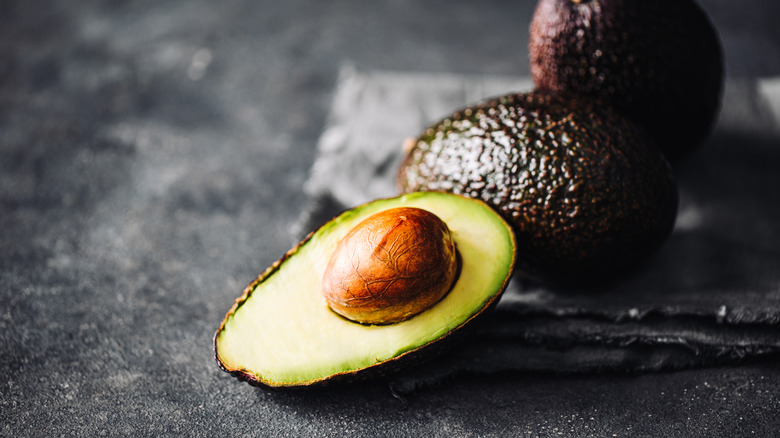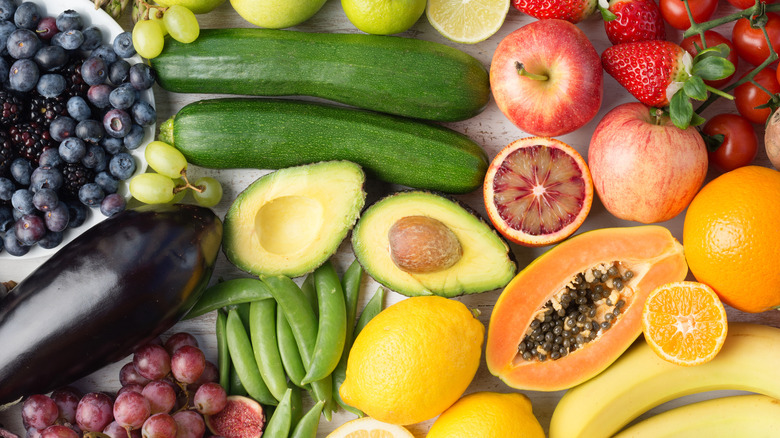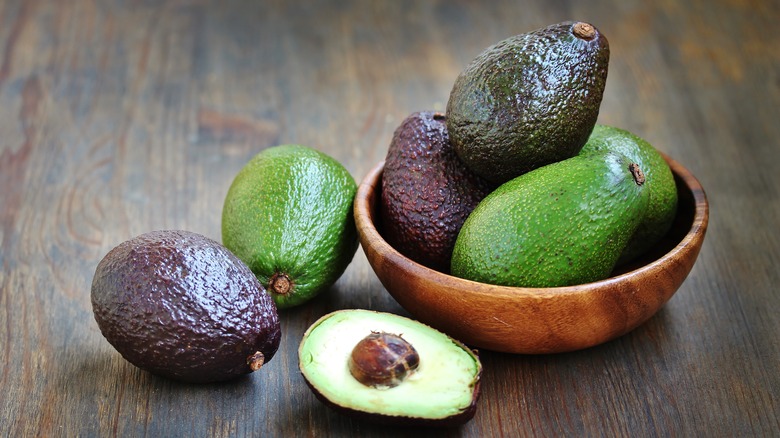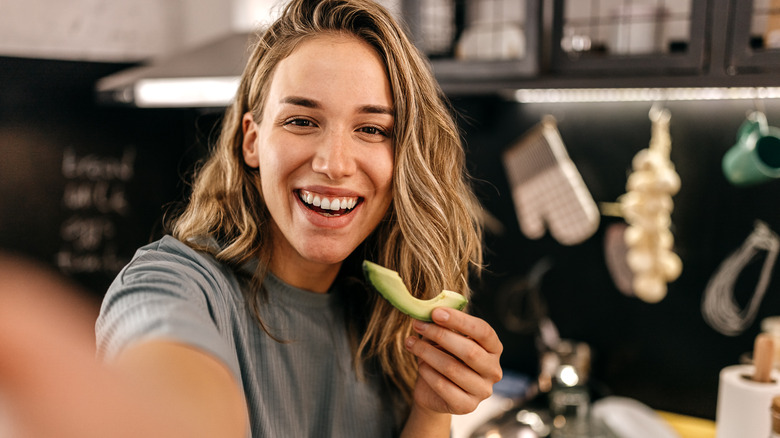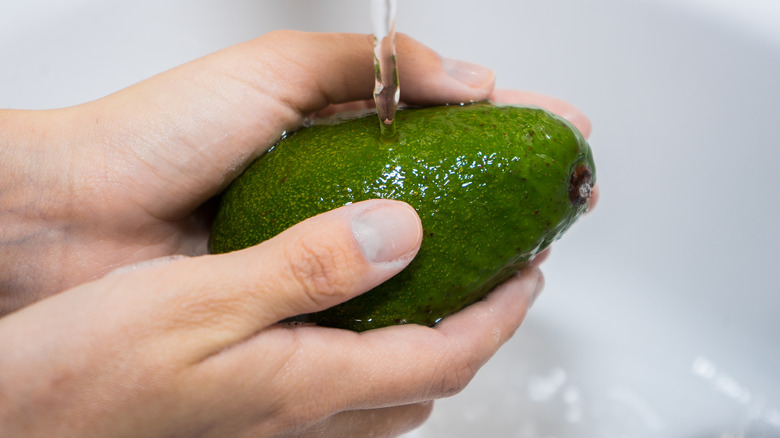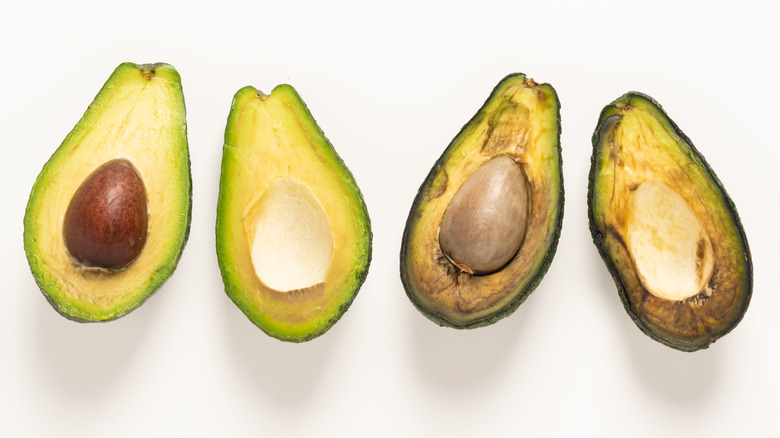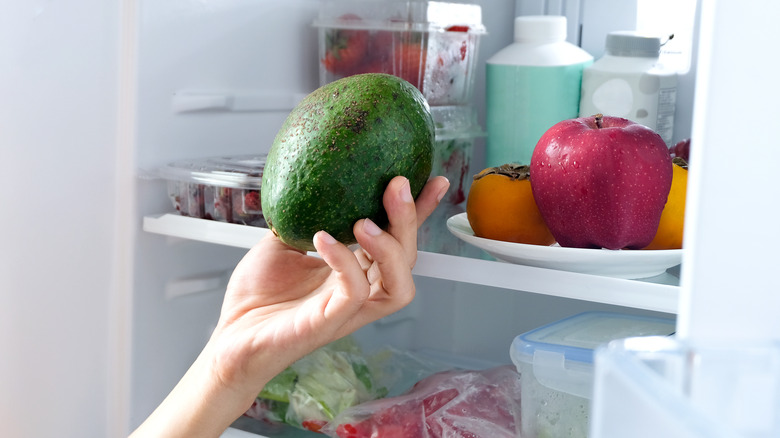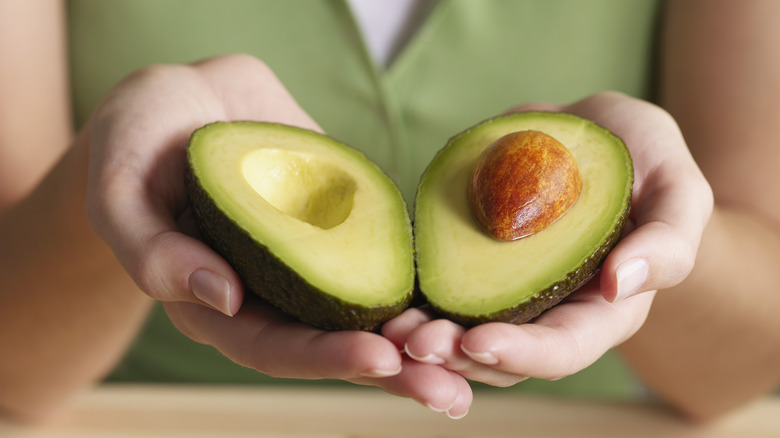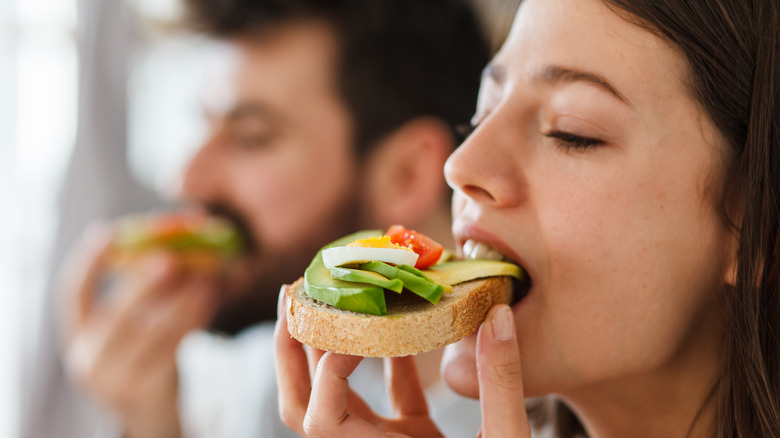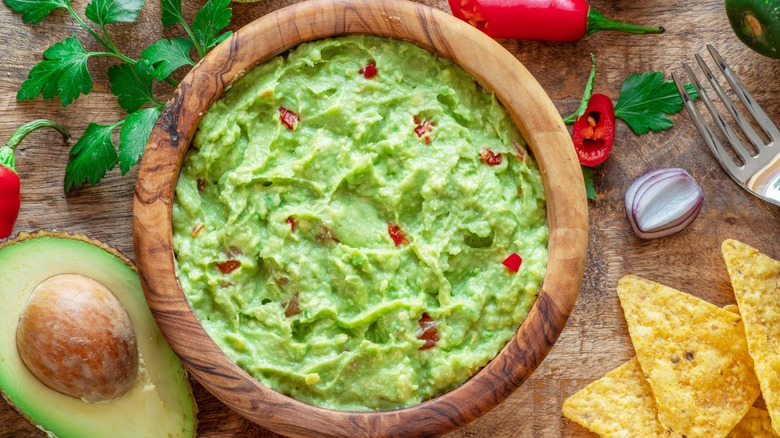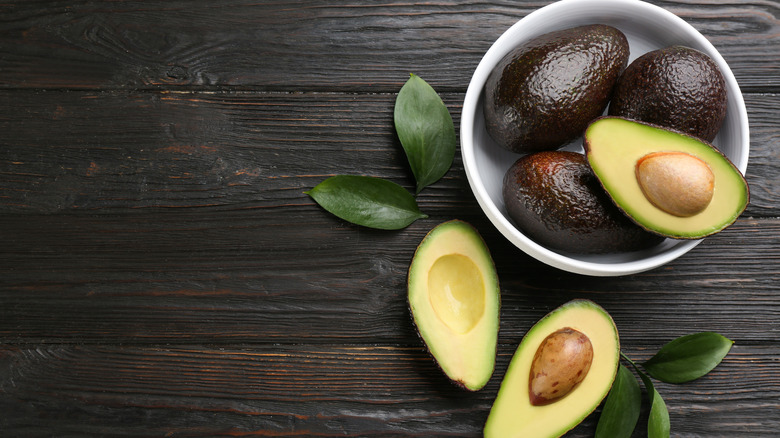False Facts About Avocados You Thought Were True
Avocados have experienced a remarkable surge in popularity in the U.S. since the 1980s. According to Statista, the per capita consumption of avocados in the country grew from 2.23 pounds in 2000 to an astonishing 9.22 pounds in 2022. So why this sudden obsession with avocados? Several factors have contributed to the skyrocketing popularity of this creamy fruit, from the FDA relaxing importation rules to becoming a trend on restaurant menus to a series of successful Super Bowl marketing campaigns.
First, avocados have gained a reputation as a superfood due to their numerous health benefits. Avocados are a rich source of fiber, healthy fats, folate, magnesium, potassium, and vitamins B, C, E, and K. Avocados are also free of cholesterol and contain little sodium. Over the years, avocados have become a staple of the North American culinary scene. From avocado toast and smoothie bowls to salads, sandwiches, and even desserts, the versatility of avocados in the kitchen has made them a beloved ingredient in both restaurant and home kitchens.
Despite their popularity, avocados remain shrouded in a web of misconceptions. Hold onto your hats because we are about to debunk some of the most common false facts about avocados that you might have believed to be true.
Avocados are vegetables
Many people share the misconception that avocados are vegetables. This could be due to their savory and rich flavors, or the way they are used in cooking. Just like vegetables, avocados are commonly tossed into salads, or used as an ingredient in sandwiches and wraps. Additionally, much like vegetables, they are used in dips and spreads such as guacamole. Some other fruits that are frequently mistaken for vegetables include tomatoes, eggplants, pumpkins, cucumbers, and bell peppers.
Despite their savory taste, creamy texture, and various culinary applications, avocados are botanically classified as a fruit rather than a vegetable. To be precise, avocados have earned this designation because they have a pit and originate from a flower. Unlike vegetables, which are usually comprised of stems, flower buds, or roots, avocados are even more specifically categorized as single-seeded berries, despite their dissimilarity to strawberries, blueberries, or raspberries.
There's only one type of avocado
When we think about avocados, we usually picture the Hass avocado, a pear-shaped fruit with a pebbly and thick skin that turns from green to purplish-black as it ripens. While this is the most popular variety of avocados in the U.S., it's by no means the only one. There are more than 500 different types of avocado grown around the world, each varying in shape, color, and texture. Interestingly, there are over 50 varieties of avocados cultivated solely in Florida.
While new varieties of avocados are continually being developed through cross-breeding, the roots of all avocados can be linked back to three very distinct geographical locations: Mexico, Guatemala, and West India. One of the notable types of avocado is the Choquette from South Florida. This avocado type is typically larger than Hass and boasts smooth green skin and high moisture content, resulting in a lighter flavor and less creamy texture. Another variety, the Bacon avocado, has a thin and smooth skin that remains green even when it's ripe. True to its name, this type of avocado is known for its slightly smoky taste. Moving to more unique varieties, the Russell avocado is particularly intriguing due to its relatively large size and elongated shape.
Avocados are fattening
Avocados have a high fat content. In fact, a medium avocado has around 22 grams of fat, as well as 240 calories, 10 grams of fiber, and 13 grams of carbohydrates. While some automatically associate high fat content with weight gain and unhealthy eating habits, there's much more to the story when it comes to avocados. This is because not all types of fat are created equal.
The 22 grams of fat in an average avocado can be broken down into 15 grams of monounsaturated fat, four grams of polyunsaturated fat, and three grams of saturated fat. Monounsaturated fat and polyunsaturated fat are both unsaturated fats that aren't linked with weight gain. Also found in vegetable oils and nuts, these so-called good fats are beneficial in several ways. They can lower LDL cholesterol, minimize the risk of heart problems, provide various nutrients, and help in vitamin absorption. Additionally, avocados provide a substantial amount of fiber, a key player in promoting a lasting sense of fullness.
You don't need to wash avocados
Since avocados aren't consumed with the skin, some people don't think that it's necessary to wash them. This perspective is further bolstered by the fact that avocado skin is relatively thick, protecting the inner flesh from any harmful substances or bacteria. While not washing your avocados is certainly convenient, it could get you and your loved ones in a whole lot of trouble. This is because any harmful substances on the avocado's surface, such as bacteria or pesticides, can be transferred to the edible flesh during the cutting or peeling process.
If you think the risk of cross-contamination is negligible, think again. A 2018 FDA report, which tested 1,615 avocados for bacteria, found that 17.73% of them had traces of listeria on the skin. Listeria can lead to listeriosis, which can have serious consequences for pregnant people and the elderly. The news isn't all bad, however. The same study also revealed that only 0.74% of avocado skins were contaminated with salmonella. Although this percentage is relatively small, we believe that it's still wise to exercise caution.
You can't stop avocados from going brown once they are cut
Avocados turn brown when cut due to a reaction known as enzymatic browning, which takes place when the flesh of the fruit is exposed to oxygen. Some other fruits that are susceptible to enzymatic browning include bananas, apples, and pears. While brown avocado flesh is perfectly safe to eat, it can look unsightly and change the taste of the fruit, turning it somewhat bitter.
Luckily, there are a few simple steps you can take to prevent your avocado from changing color once it's cut or mashed. First, you can squeeze lemon or lime juice over the cut avocado. The citric acid in these fruits will help slow down the browning process. Alternatively, you can brush the avocado with a little olive oil or honey to create a barrier between the fruit's flesh and oxygen. Next, you can store the avocado with a slice of onion, which releases sulfur that can help keep it green. Lastly, it's always a good idea to keep your avocados in an airtight container or cover them in plastic wrap since this limits the fruit's contact with oxygen.
You shouldn't store avocados in the fridge
Some avocado enthusiasts believe that refrigerating avocados harms their color and texture, but this is a misconception. In reality, refrigeration can help maintain the fruit's quality — especially after it has ripened — by preserving its flavor and consistency for a longer period.
Avocados, like many other fruits, continue to ripen after being harvested. When placed in the refrigerator, the cold temperature can significantly slow down this process. This can be disadvantageous if the avocados are not yet ripe when refrigerated, as they may take a very long time to reach optimal ripeness, or in some cases, they may never ripen at all. This is why it's important to keep unripened avocados at room temperature on your countertop, allowing them to reach their peak ripeness naturally. Once fully ripe, avocados can be moved to the refrigerator to prolong their shelf life. Ripe avocados should be eaten within five days of refrigeration.
Keeping the pit in the avocado will keep it from going brown
It's a common misconception that keeping the seed in the avocado will stop the fruit from going brown after it's cut. Some even extend this theory to guacamole, claiming that placing a pit in a bowl of guac will keep it fresh and green. Unfortunately, avocado seeds don't possess any magical powers, and you can expect your fruit to slowly start turning brown once cut, pit or no pit.
Browning is the result of oxidation, a process where the avocado's flesh is exposed to oxygen. An avocado pit doesn't contain any special substance that could prevent or slow down this process. The idea that keeping a pit in the avocado once it's been cut can stop it from discoloration probably comes from the fact that the pit protects the flesh immediately below it from oxygen, ensuring that it remains appealing and green. Thus, while it won't make a huge difference, it's a good idea to keep the seed in place until the avocado is ready for consumption.
You can microwave avocados to speed up the ripening process
Most of us have been there — craving guacamole only to realize that our avocados are still unripe. According to one school of thought, this is where a microwave can help. However, while popping an avocado in the microwave — or the oven — can soften the fruit, it won't make it ripe in the traditional sense of the word. A microwaved avocado will still taste unripe and lack the creaminess of an avocado that's been allowed to ripen naturally.
Avocados release ethylene gas, and it's precisely this substance that ensures they ripen once harvested. This is why microwaving an avocado will only soften the fruit without changing its taste. If you do decide to go the microwave route, slice the avocado open and remove the seed before wrapping it in microwave-safe cling wrap. To obtain the best possible result, microwave avocados on medium heat in 30-second intervals.
Other methods can also be used to speed up the ripening process of an avocado. Most of them rely on increasing the ethylene gas around the fruit. Since avocados produce ethylene gas, popping them in a paper bag can accelerate the rate at which they ripen. If you don't happen to have a paper bag on hand, you can always improvise. The more creative home chefs have been known to place avocados in beer koozies to promote the ripening process.
It's bad to eat avocados every day
Can you have too much of a good thing? Some people certainly think so, particularly when it comes to avocados. In fact, a common myth warns against eating the creamy fruit on a daily basis. This is mainly due to avocado's relatively high fat and carb content. While it's probably not a great idea to overindulge in avocados — or any other produce, for that matter — eating an avocado a day is unlikely to lead to weight gain, as highlighted by EatingWell.
It's important to note that the fat in avocados is primarily made up of monounsaturated and polyunsaturated fats, which are considered good for heart health. Avocados are also a great source of fiber, which can help you feel fuller for longer, potentially aiding in weight management. Additionally, despite their relatively high carbohydrate content, a research paper published in the Journal of American Heart Association found that people who indulged in an avocado a day for six months didn't experience any excessive weight gain.
You can't freeze avocados
Sometimes, the allure of a supermarket deal can be hard to resist. However, there's no reason to despair if you find yourself with too many avocados. The good news is that you can freeze them before they become overly ripe. Whether you're keeping them for smoothies or guacamole, freezing avocado is a great solution for ensuring that none of this creamy fruit goes to waste.
While frozen avocados won't be of the same quality as their fresh counterparts, they are perfect for recipes where the texture isn't the main focus. This is because freezing avocados can affect their consistency, making the fruit mushy when defrosted. Avocados contain a lot of water, which crystallizes when frozen. This crystallization is precisely what affects the fruit's texture upon thawing.
To freeze an avocado, it's best to remove its skin and pit and cut it into halves or even cubes. Next, coat the avocado with a little lime or lemon juice to stop it from browning. To minimize oxidation, it's also best to place the avocado in an airtight container or a resealable plastic bag. You can also freeze mashed avocados in the same way. Avocados can stay frozen for up to a month.
Avocados cause constipation
While we have no idea where this myth originates, the idea that avocados cause constipation couldn't be further from the truth. In reality, incorporating avocados into a balanced diet, along with adequate fluid intake and physical activity, is more likely to promote digestive health rather than hinder it.
Avocados are an excellent source of both soluble and insoluble fiber, which are key components for healthy digestion. The average avocado contains 10 grams of dietary fiber, which constitutes 40% of the daily recommended intake of fiber for women and 28% for men. While soluble and insoluble fibers serve different functions, they are both important for digestive health by helping to move food through the digestive tract at a faster rate. In addition, foods like avocados, which are high in unsaturated fats and low in saturated fats, are said to lubricate the gastrointestinal tract to alleviate constipation and promote healthy bowel movements.
You can't eat avocado pits and skin
While most people only consume avocado flesh, dismissing the pits and skin as inedible, there are many creative ways to make use of every part of this versatile fruit. Avocado seeds contain fatty acids, dietary fiber, and starch, and may in fact be beneficial for heart health. They also have anti-fungal and bacterial properties. While studies are still being conducted, currently there's no evidence that consuming avocado seeds is unsafe. So how do you eat avocado pits? Since they are relatively hard, it's best to bake the seeds in the oven at high heat for a couple of hours. Once softened, the pits can be chopped up and blended into powder that can be added to smoothies, dips, and sauces.
Similar to avocado seeds, the skin of an avocado is also considered safe for consumption. However, given that avocado skin is tough and bitter, it's easy to understand why many might prefer not to eat it. Nevertheless, like the skins of some other fruits and vegetables, avocado skin constitutes the most nutritious part of the fruit. It's rich in beneficial nutrients including antioxidants, fiber, vitamins, flavonoids, and phenols. As with avocado pits, a good way to incorporate avocado skin into your diet is by blending it into a powder.
